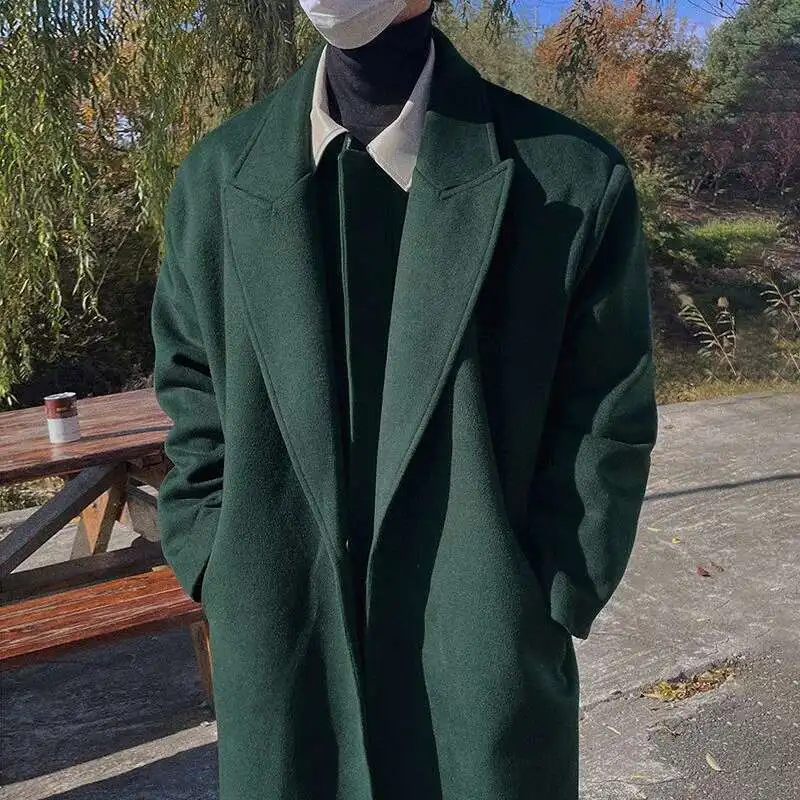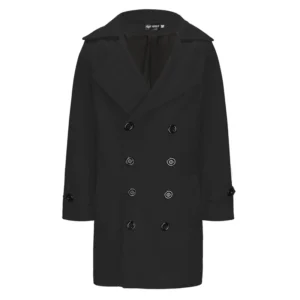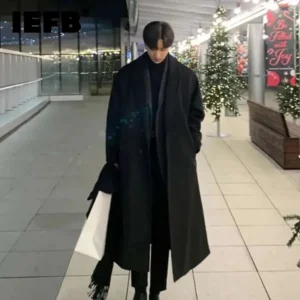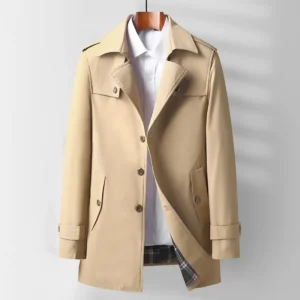The Importance of Getting Coat Length Right
When it comes to men’s outerwear, coat length is a critical yet often overlooked detail that can dramatically transform your entire appearance. The right coat length doesn’t just affect how warm you’ll be—it fundamentally shapes your silhouette, impacts perceived height, and sets the formality tone of your entire outfit.
Think of your coat as the frame that presents your overall look to the world. A coat with improper length can make even the most expensive, high-quality garment look ill-fitted and diminish your entire presentation. Throughout history, coat lengths have evolved with changing fashion standards, but the principle remains: proper proportion is timeless.
The impact of coat length is especially noticeable in important settings like job interviews, formal events, and business meetings where first impressions matter significantly. A well-proportioned coat communicates attention to detail and style awareness without saying a word.
Key takeaways about coat length importance:
– It directly affects your perceived height and body proportions
– It establishes the formality level of your entire outfit
– It can either elevate or undermine the quality impression of the garment
– It contributes significantly to comfort and functionality
Understanding the principles behind choosing the right coat length forms the foundation for developing a sophisticated personal style that works with—rather than against—your unique body type and lifestyle needs.
Understanding Men’s Coat Length Classifications
Before diving into specific recommendations, it’s essential to understand the standard categories of coat lengths and how they’re measured. These classifications provide a common language to discuss coat proportions and help identify the right style for different needs.
Standard Coat Length Categories:
Short/Hip Length (28-30 inches / 71-76 cm)
– Hits at or just below the hip
– Includes bomber jackets, cropped styles, and many casual jackets
– Typically ends near the top of the pants pocket
Mid/Thigh Length (32-35 inches / 81-89 cm)
– Extends to mid-thigh area
– Includes car coats, peacoats, and many casual winter coats
– Usually covers the seat completely
Knee Length (36-38 inches / 91-97 cm)
– Reaches to the knee or just above
– Includes classic overcoats, trench coats, and traditional topcoats
– Considered the standard length for formal overcoats
Below-Knee/Full Length (40+ inches / 102+ cm)
– Extends below the knee, sometimes to mid-calf
– Includes formal overcoats, full-length trench coats, and some statement pieces
– Most formal and traditional option
Modern interpretations of these lengths tend to be slightly shorter than their historical counterparts, with contemporary styles often favoring a trimmer silhouette. However, classic proportions remain relevant for formal settings and traditional styling.
The comprehensive men’s coat length guide shows that these classifications aren’t just about measurement numbers but about how the coat interacts with your body’s natural lines and proportions. Understanding these standard categories provides the foundation for making informed choices about which styles will work best for your specific needs.
Key Factors That Should Determine Your Coat Length
While general guidelines are useful, choosing the perfect coat length requires consideration of several personal factors. These considerations will help you prioritize which length characteristics matter most for your specific situation.
Body Type and Proportions
- Your height and build fundamentally affect how different coat lengths appear on you
- Proportion between torso and legs determines how balanced a specific length will look
- Shoulder width and chest size influence how the coat drapes from top to bottom
Occasion and Formality
- More formal settings typically call for longer coat lengths
- Business environments generally require knee-length or longer options
- Casual settings allow for shorter, more functional lengths
- The level of tradition associated with an event impacts appropriate coat length
Personal Style
- Your overall aesthetic should inform coat length choices
- Modern, contemporary styles often feature slightly shorter lengths
- Traditional or classic dressers may prefer standard or longer lengths
- Style confidence matters more than rigidly following rules
Functionality and Weather
- Colder climates may necessitate longer coats for better protection
- Activity level determines practical length needs (driving, commuting, walking)
- Layering requirements affect how much length is needed for comfort
Outfit Coordination
- What you wear beneath the coat influences optimal length
- Formal suits generally pair best with longer coats
- Casual wear often works better with shorter coat styles
When these factors conflict, prioritize based on the primary function of the coat. For instance, if you’re selecting a coat primarily for harsh winter conditions, functionality might outweigh some style considerations, while a coat for business settings might prioritize formality over maximum weather protection.
Understanding how to select the perfect coat length for your height helps balance these considerations effectively, creating a harmonious and flattering appearance regardless of the specific circumstances.
Finding Your Perfect Coat Length Based on Height
Height is perhaps the most significant physical factor affecting coat length selection. The right proportion creates visual harmony, while the wrong length can throw off your entire silhouette. Here’s how to choose wisely based on your height:
For Shorter Men (Under 5‘7” or 170 cm)
- Avoid lengths that extend below mid-thigh as they can overwhelm your frame
- Hip-length and car coat lengths (ending at upper thigh) typically create the most balanced look
- Ensure the coat doesn’t extend past the knuckles of your hands when arms are at rest
- Look for styles that create a clean vertical line without excess fabric
- Consider slightly shorter sleeves that hit right at the wristbone to lengthen the appearance of arms
For Average Height Men (5‘7”-5‘11” or 170-180 cm)
- Most versatile height range with ability to wear many different lengths
- Thigh-length to just above the knee typically offers the most balanced proportion
- Can experiment with both shorter styles for casual looks and knee-length for formal settings
- Maintain proportion by ensuring the coat doesn’t cover more than two-thirds of your total height
- Focus on proper shoulder fit as this will influence how the entire length drapes
For Taller Men (6‘0”/183 cm and above)
- Can generally wear longer lengths without being overwhelmed
- Knee-length and below-knee options often look particularly distinguished
- Avoid excessively short styles that may make arms and legs appear disproportionately long
- Consider custom lengths for perfectly balanced proportions
- Look for brands that offer “tall” sizing with proportionally longer sleeves
Height creates optical illusions that proper coat length can either enhance or minimize. For instance, the right length can make shorter men appear taller by creating an unbroken vertical line, while taller men can use length strategically to balance their proportions.
Common misconceptions include thinking that taller men should always wear longer coats or that shorter men should always wear very short coats. In reality, the proportion between your upper and lower body is more important than height alone.
Learning which coat length options can make you appear taller provides valuable strategies for using outerwear to enhance your natural proportions, regardless of your actual height.
How Body Build Affects Your Ideal Coat Length
While height provides a starting point for coat length, your overall body build significantly refines what works best for your unique physique. Different body types require specific adaptations to create balanced proportions.
Slim/Athletic Build
- Can generally wear a wider range of lengths without overwhelming the frame
- Shorter lengths work well to showcase a trim silhouette
- Longer styles can add substance to a slender frame when desired
- Pay attention to shoulder fit to maintain clean lines throughout the coat
Average Build
- Focus on balanced proportions that neither add visual weight nor look oversized
- Mid-thigh to knee lengths typically offer the most versatile and flattering fit
- Ensure the coat tapers slightly at the waist for definition without being tight
- Look for styles that maintain consistent proportion from shoulders through hem
Broader Build
- Avoid excessively short lengths that can make the upper body appear disproportionately wide
- Knee-length options often create a more balanced visual effect
- Ensure adequate room through chest and shoulders without excess fabric
- Look for subtle tapering through the body to create a defined silhouette
- Consider slightly structured shoulders to create clean lines
The distribution of weight across your body also matters significantly. Men who carry more weight in their midsection may benefit from slightly longer coats that create a more streamlined silhouette, while those with broader shoulders but narrower hips might prefer shorter styles that highlight their V-shaped physique.
When considering both height and build together, sometimes these factors create competing recommendations. In such cases, prioritize what feels most comfortable and looks most harmonious to your eye, as confidence in wearing the garment ultimately enhances its appearance.
Finding the perfect coat length for every body type involves balancing these considerations with personal comfort preferences and intended use of the coat.
Matching Coat Length to Different Occasions
Coat length plays a crucial role in appropriateness for specific settings. The formality of an occasion directly correlates with traditional coat length expectations, though modern interpretations have introduced some flexibility.
Formal Business and Black-Tie Events
- Knee-length to below-knee overcoats represent the gold standard
- Full-length topcoats create a distinguished, formal silhouette
- Dark colors (charcoal, navy, black) enhance the formal effect of longer lengths
- Structured shoulders and clean lines reinforce the formality
- Ensure the coat fully covers a suit jacket underneath without excess bunching
Business Casual and Smart Casual Settings
- Mid-thigh to knee-length options strike the right balance
- Car coats and shorter overcoats work well for less traditional offices
- Look for clean lines and minimal detailing for versatility
- Slightly shorter lengths can bridge the gap between formal and casual contexts
Everyday Casual Wear
- Hip to mid-thigh lengths offer practical everyday functionality
- Bomber jackets, peacoats, and shorter car coats create relaxed yet put-together looks
- More variety in styling details is acceptable
- Prioritize comfort and ease of movement
- Consider how the coat will work with casual weekend attire
Outdoor Activities and Functional Needs
- Hip-length technical jackets provide mobility for active pursuits
- Mid-thigh options balance protection with freedom of movement
- Consider how the coat will perform while sitting in vehicles
- Prioritize length that provides adequate coverage for intended activities
Traditional dress codes have historically associated longer coat lengths with greater formality, a principle that remains largely valid despite modern variations. Understanding these associations helps ensure your outerwear sends appropriate signals about your attention to occasion-appropriate dress.
For those seeking guidance on elevated outerwear options, exploring men’s dress coats for various events provides additional context for matching coat formality to specific occasions.
Styling Different Coat Lengths: A Visual Guide
Each coat length category presents unique styling opportunities and challenges. Mastering these pairings helps create cohesive, balanced outfits regardless of which length you choose.
Short/Hip-Length Coats and Jackets
- Perfect partners for casual denim, chinos, and even dress pants
- Create visual balance by avoiding overly baggy pants
- Work well with both untucked casual shirts and tucked-in options
- Ideal for showcasing statement belts or interesting waistlines
- Layer effectively over lightweight sweaters and hoodies
- Complete the look with boots or sneakers depending on desired formality
Mid-Length/Thigh-Length Coats
- The most versatile length for pairing with different outfit types
- Balance well with both casual and dress pants
- Work effectively over light suit jackets or sport coats
- Layer comfortably over multiple underneath layers
- Pair with scarves that can be tucked inside for a clean look
- Complete with either casual or formal footwear based on the coat style
Knee-Length Classic Coats
- Create sophisticated looks when worn over suits or formal attire
- Require pants with a proper break to maintain proportion
- Typically call for more formal footwear like dress boots or leather shoes
- Layer beautifully with dress scarves and leather gloves
- Create a streamlined appearance when buttoned
- Work best when the underlying jacket or suit is slightly shorter
Below-Knee/Long Coats
- Make a dramatic statement that works best with formal attire
- Pair with well-tailored trousers that create a clean line
- Require attention to overall silhouette to avoid overwhelming the frame
- Layer effectively with suit jackets, blazers, or even turtlenecks
- Complete with formal leather shoes and refined accessories
- Create the most formal impression when in traditional dark colors
Seasonally, shorter coats often transition well into fall and spring, while longer options provide maximum protection during winter months. The weight of the fabric should align with both the season and the coat length for proper proportion and function.
For those interested in specific pattern options, the definitive guide to men’s herringbone wool coats offers excellent insights into styling this classic pattern across different coat lengths.
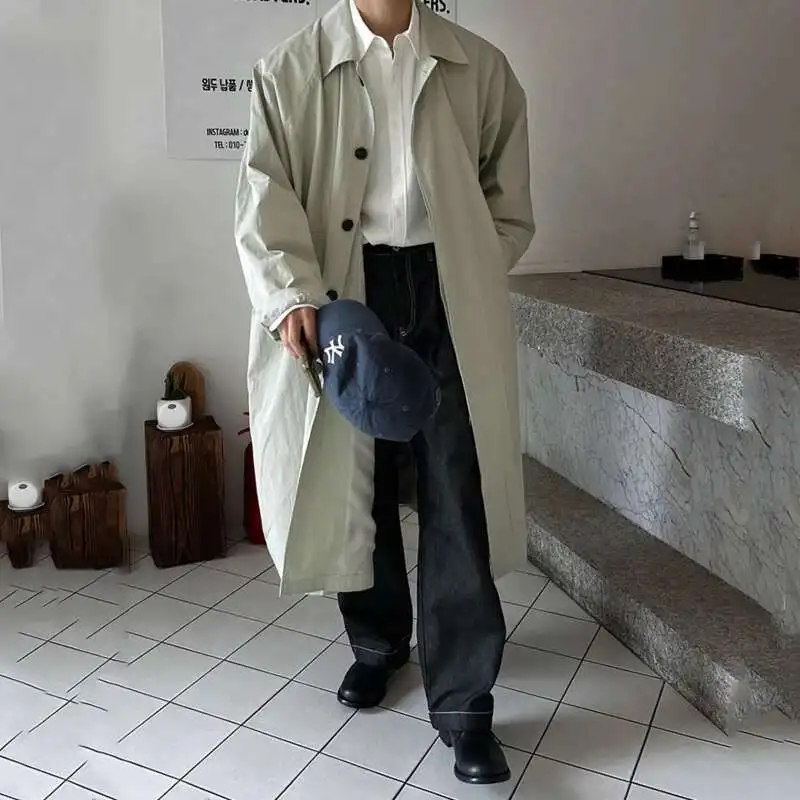
Spotlight on Popular Coat Types and Their Ideal Lengths
Different coat styles have traditional length standards that have evolved through history. Understanding these conventions helps determine whether a particular coat meets classic proportions or offers a contemporary interpretation.
Overcoats and Topcoats
- Traditionally knee-length (38-42 inches / 96-107 cm)
- Modern versions may be slightly shorter (36-40 inches / 91-102 cm)
- Should fully cover a suit jacket or blazer underneath
- Classic proportions extend to just below the knee
- Contemporary styles may hit just above the knee
- Most versatile when they reach mid-knee area
Trench Coats
- Traditional length reaches mid-knee (40-45 inches / 102-114 cm)
- Modern variations may be shorter for casual styling
- Classic designs include belt at natural waist
- Should be long enough to provide adequate rain protection
- Shorter versions (ending at mid-thigh) work better for casual settings
- Full-length options create the most dramatic and classic look
Peacoats
- Traditionally end at mid-thigh (30-35 inches / 76-89 cm)
- Authentic naval designs are shorter for practical functionality
- Should cover the suit jacket or blazer completely
- Modern interpretations may be slightly shorter for casual styling
- Most flattering when they hit just below the hip bone
Car Coats
- Classic length hits at mid-thigh (32-36 inches / 81-91 cm)
- Designed originally to end just below the seat when seated in vehicles
- Contemporary versions maintain similar proportions
- Should be long enough to provide adequate warmth while driving
- Works best when hem falls at fingertips with arms at sides
Bomber Jackets and Casual Short Styles
- Traditionally end at the hip (24-28 inches / 61-71 cm)
- Should hit at or just below the waistline of pants
- Creates a casual, youthful silhouette
- Modern variations maintain similar proportions with slight variations
- Most flattering when they hit at the top of the hip bone
When determining if a coat’s length flatters you, consider whether it creates a balanced proportion between your upper and lower body, with neither appearing disproportionately long or short. The coat should create clean lines without bunching or pulling when buttoned.
Exploring various men’s overcoats can provide visual examples of how different length standards apply to specific coat styles.
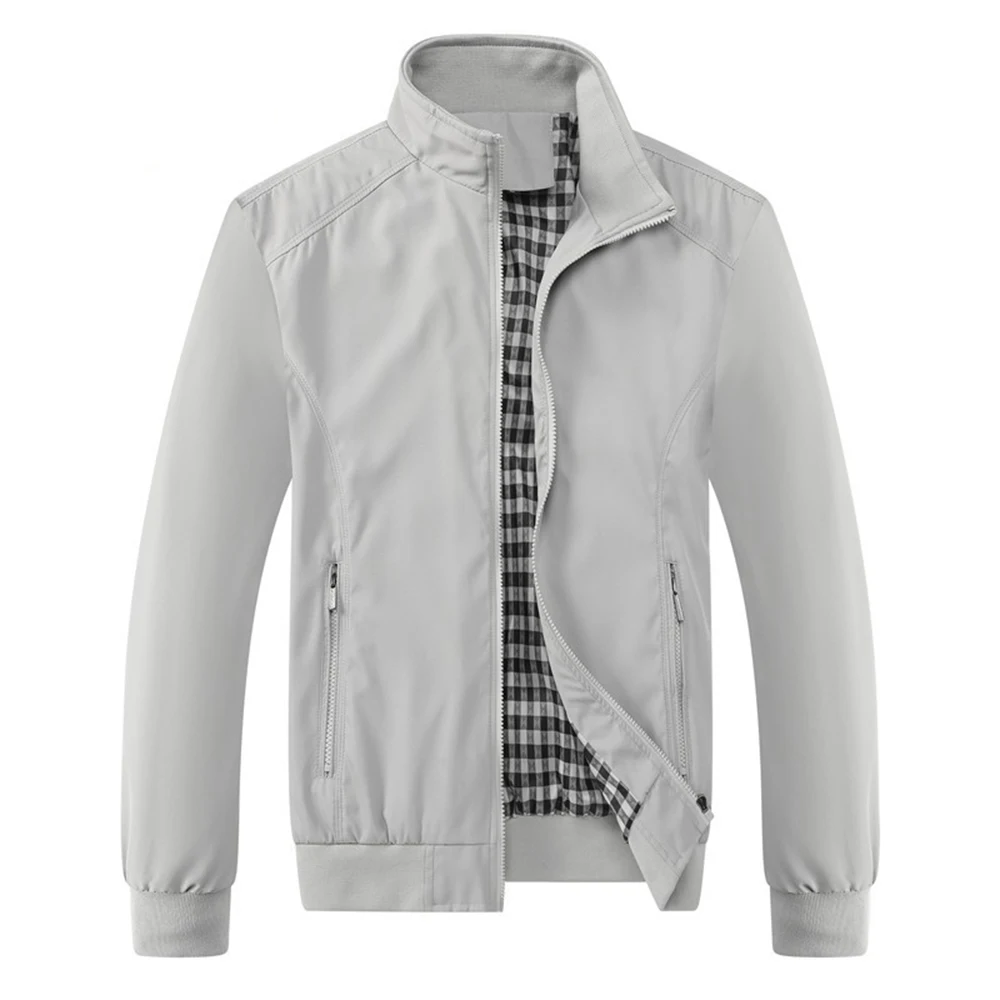
Beyond Length: Critical Fit Points That Affect Your Coat’s Look
While length is crucial, several other fit elements work together with proper length to create a harmonious overall appearance. Even the perfect length can’t compensate for issues in these other key areas.
Shoulder Alignment and Width
- Coat shoulders should align with your natural shoulder edge
- Excessively wide shoulders create a sloppy, oversized appearance
- Too-narrow shoulders restrict movement and create pulling
- Properly fitted shoulders create a clean foundation for the entire garment
- Look for the sleeve seam to sit right at the edge of your shoulder
Sleeve Length Proportion
- Sleeves should end at the base of your thumb when arms are relaxed
- Allow approximately ¼ to ½ inch of shirt cuff to show beyond coat sleeve
- Ensure consistent length between both sleeves
- Too-short sleeves make even expensive coats look ill-fitting
- Sleeve width should allow for layering without excessive fabric
Chest and Waist Fit
- The coat should button comfortably without pulling or gapping
- Allow enough room for layering underneath without looking bulky
- A slight taper at the waist creates shape without constriction
- The lapels should lie flat against the chest without buckling
- When buttoned, the front panels should meet cleanly without strain
Overall Drape and Movement
- The coat should hang cleanly from shoulders without rumpling
- Back vents (when present) should remain closed while standing
- Fabric should move naturally with your body without restriction
- No horizontal pulling or wrinkles when buttoned
- The coat should feel comfortable through full range of typical movements
These fit elements work together with proper length to create a polished appearance. For instance, a coat with perfect length but poor shoulder fit will never look right, regardless of quality or price point.
Many wool overcoats demonstrate these fit principles effectively, showing how quality construction supports proper drape and movement.
Practical Rules of Thumb for Determining Your Ideal Coat Length
When shopping for coats, these straightforward guidelines can help you quickly assess whether a length works for your body and needs:
The “Covers the Seat” Rule: For casual and business coats, the hem should fully cover your seat for both proper proportion and practical warmth.
The “Hand Position” Rule: With arms relaxed at your sides, the coat hem should fall somewhere between your knuckles and mid-palm for optimal balance.
The “Proportion Preservation” Rule: Your coat should cover approximately 2/3 of your total height for traditional proportion, slightly less for more contemporary styling.
The “Suit Coverage” Rule: Formal overcoats should extend 5-6 inches beyond your suit jacket hem to maintain proper coverage and proportion.
The “Mirror Test”: When viewed from behind, the coat hem should create a horizontal line that balances your overall silhouette.
The “Seated Comfort” Test: When sitting, the coat shouldn’t bunch excessively at the hips or ride up uncomfortably.
These guidelines have flexibility based on current fashion trends and personal preference. For instance, more fashion-forward styles might intentionally break the proportion preservation rule for dramatic effect.
When trying on coats, sit down, reach forward, and move naturally to ensure the length works not just when standing perfectly still but during regular daily activities.
The collection of men’s long overcoats demonstrates these principles in action across various styles and materials.
Mens Double Breasted Pea Coat, Mens Wool Blend Coat, Mens Wool Pea Coat
Price range: $136.84 through $157.36 Select options This product has multiple variants. The options may be chosen on the product pageMens Cashmere Overcoat, Mens Hooded Winter Coat, Mens Wool Blend Coat
Price range: $128.72 through $139.68 Select options This product has multiple variants. The options may be chosen on the product pageMens Black Overcoat, Mens Black Wool Coat, Mens Wool Overcoat
$339.18 Select options This product has multiple variants. The options may be chosen on the product pageMens Grey Overcoat, Mens Wool Blend Coat, Mens Wool Overcoat
$201.28 Select options This product has multiple variants. The options may be chosen on the product pageMens Herringbone Coat, Mens Long Overcoat, Mens Wool Overcoat
Price range: $197.16 through $203.69 Select options This product has multiple variants. The options may be chosen on the product pageMens Long Overcoat, Mens Topcoats
Price range: $189.40 through $196.88 Select options This product has multiple variants. The options may be chosen on the product page
Common Coat Length Mistakes and How to Avoid Them
Even style-conscious men sometimes make these common coat length errors. Recognizing and avoiding these pitfalls can significantly elevate your outerwear game:
Mistake: Choosing Lengths That Diminish Height
Problem: Very short men selecting extremely short coats or very tall men wearing floor-length styles that exaggerate their height.
Solution: Focus on balanced proportions rather than trying to dramatically compensate for height. For shorter men, coats that end at mid-thigh create a lengthening effect without looking awkward. Taller men should avoid styles that extend far below the knee.
Mistake: Selecting Inappropriately Casual/Formal Lengths
Problem: Wearing hip-length casual jackets to formal business meetings or full-length formal overcoats with casual weekend wear.
Solution: Match coat length to the formality of the occasion and underlying outfit. Keep at least one versatile mid-length option in your wardrobe for situations that fall between casual and formal.
Mistake: Failing to Account for Layering
Problem: Buying a coat that fits perfectly over a t-shirt but becomes uncomfortably tight over a suit jacket or sweater.
Solution: When trying on coats, wear or bring along the bulkiest items you’ll typically wear underneath. Ensure the coat accommodates these layers without significant changes to its drape or length appearance.
Mistake: Following Trends Without Considering Body Type
Problem: Adopting extremely short or long trend-driven styles that fight against your natural proportions.
Solution: Adapt current trends to your body type by moderating extreme lengths. If oversized coats are trending, choose one that’s slightly roomier rather than drastically oversized.
Many of these mistakes stem from prioritizing a specific feature (like color or material) over proper fit and proportion. Remember that no design detail can compensate for improper length.
For formal occasions, choosing from quality men’s dress coats with proper length specifications can help avoid these common errors.
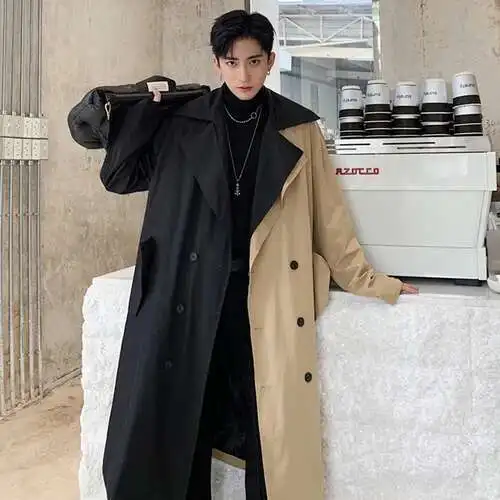
Is a Custom-Length Coat Worth the Investment?
For many men, standard off-the-rack coat lengths work perfectly well, particularly those with average height and proportions. However, there are circumstances when considering custom length options becomes a worthwhile investment.
When Standard Sizes Might Suffice:
- You fall within average height ranges (5‘8”-6‘0” or 173-183 cm)
- Your torso-to-leg proportions are relatively standard
- You plan to wear the coat primarily for casual occasions
- The coat is trendy rather than a long-term investment piece
- Budget constraints make custom options impractical
When Custom Length May Be Beneficial:
- You’re significantly taller or shorter than average
- You have unusual proportions (very long torso, shorter legs)
- The coat will be worn frequently for formal or business settings
- You’re investing in a high-quality piece meant to last many years
- You’ve struggled to find ready-made coats that fit properly
Coat length alterations vary in difficulty and cost. Shortening a coat hem is typically straightforward and costs $50-100, while lengthening is often impossible due to fabric limitations. Sleeve length adjustments are relatively simple, usually costing $30-60.
When evaluating quality beyond perfect length, look for natural materials, hand-stitched details, canvassed construction (in formal coats), and smooth, even seams throughout.
For those seeking quality without full custom pricing, exploring men’s wool blend coats can provide excellent options with potential for minor tailoring adjustments.
How to Choose Between Classic and Trending Coat Lengths
The tension between timeless style and current fashion presents a common dilemma when selecting coat length. Understanding how to navigate this balance helps create a versatile, yet personal wardrobe.
Classic Length Standards:
- Overcoats extending to the knee
- Peacoats ending at mid-thigh
- Trench coats reaching just below the knee
- Car coats covering the seat completely
- Bomber jackets hitting at the hip
Current Trend Considerations:
- Modern overcoats often trending slightly shorter than traditional length
- Oversized, longer silhouettes cycling in and out of high fashion
- Cropped styles gaining popularity in casual contexts
- Slim-fit coats potentially requiring length adjustments for balance
- Vintage-inspired oversized fits returning to fashion prominence
When evaluating if a trending length works for you, consider:
1. Does it flatter your natural proportions?
2. Does it serve your practical needs for warmth and coverage?
3. Will you feel confident wearing it, or self-conscious?
4. Does it align with most of your existing wardrobe?
For a sustainable approach to coat investing, consider building a wardrobe with:
– One classic-length formal overcoat (knee-length)
– One versatile mid-length option for business casual settings
– One practical shorter style for casual and active use
This strategy provides appropriate options for varied settings while allowing occasional trend-driven purchases as supplements rather than replacements.
Maintaining Proper Coat Length Over Time
Even the perfect coat length can change with improper care and storage. Protecting your investment ensures your coat maintains its intended proportions throughout its lifetime.
Proper Storage Techniques
- Always hang coats on broad, sturdy hangers that support the shoulders
- Allow space between garments to prevent crushing and stretching
- Store in breathable garment bags during off-seasons
- Never fold heavy coats for long-term storage
- Ensure storage areas are cool and dry to prevent fabric degradation
Preventing Length Issues
- Rotate between multiple coats to reduce wear stress on any single garment
- Follow care label instructions precisely, especially regarding cleaning methods
- Avoid overloading pockets, which can distort the coat’s drape over time
- Allow wet coats to dry naturally on proper hangers before storage
- Button or zip coats when hanging to maintain proper alignment
Professional Maintenance
- Have quality coats professionally cleaned and pressed annually
- Address any small repairs promptly before they affect the overall structure
- Consider light steaming rather than frequent cleaning for wool coats
- Professional pressing can restore proper drape after travel or extended storage
A quality coat represents a significant investment, and proper care ensures it maintains both its appearance and functionality. When proper length begins to change noticeably or the coat develops a permanent distortion in its silhouette, it may be time to consider replacement.
Your Coat Length Cheat Sheet: Quick Reference Guide
By Height
- Under 5‘7” (170 cm): Hip to mid-thigh length creates balanced proportions; avoid lengths below the knee
- 5‘7”-5‘11” (170-180 cm): Mid-thigh to knee length offers versatile options for most occasions
- 6‘0” and above (183+ cm): Knee to below-knee length creates distinguished look; avoid extremely short styles
By Occasion
- Formal Events: Knee-length or longer overcoats in dark, solid colors
- Business Settings: Mid-thigh to knee-length coats with clean lines and minimal detailing
- Business Casual: Mid-thigh topcoats, car coats, or shorter overcoats
- Casual Outings: Hip to mid-thigh length jackets in more relaxed styles
- Outdoor Activities: Hip-length technical jackets or mid-thigh practical coats
By Coat Style
- Overcoat/Topcoat: Traditionally knee-length; modern versions slightly shorter
- Trench Coat: Classic mid-knee length; contemporary options may hit at mid-thigh
- Peacoat: Traditional mid-thigh length covering the seat completely
- Car Coat: Mid-thigh length designed to be comfortable while seated
- Bomber/Sport Jacket: Hip length with elastic or fitted waistband
Remember that these guidelines provide starting points rather than rigid rules. Personal comfort, confidence, and individual style should always influence your final choice. The perfect coat length ultimately creates harmony with your body proportions while meeting your practical needs for both function and style.

